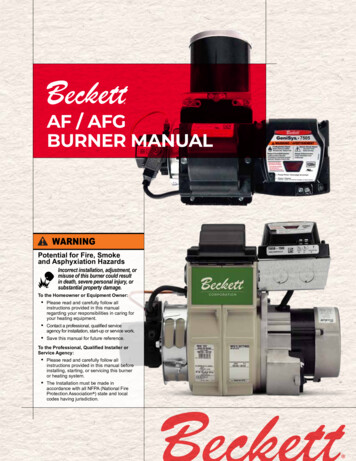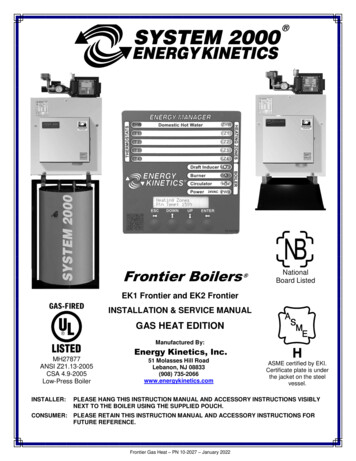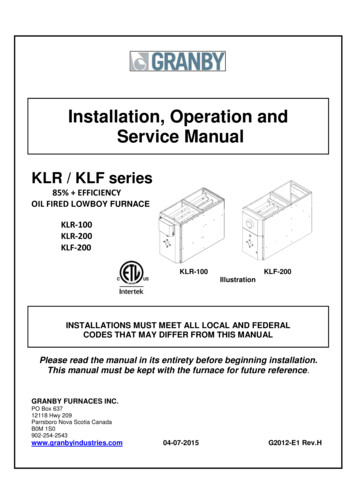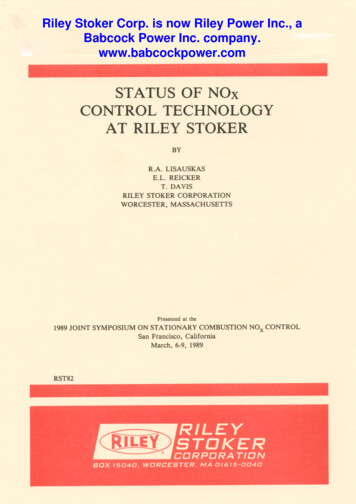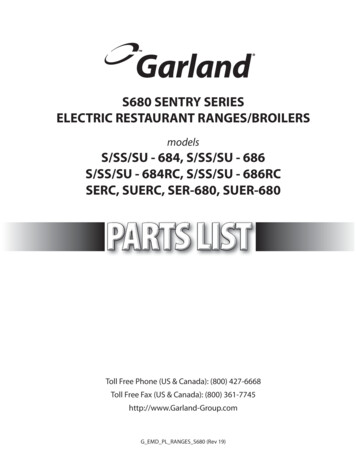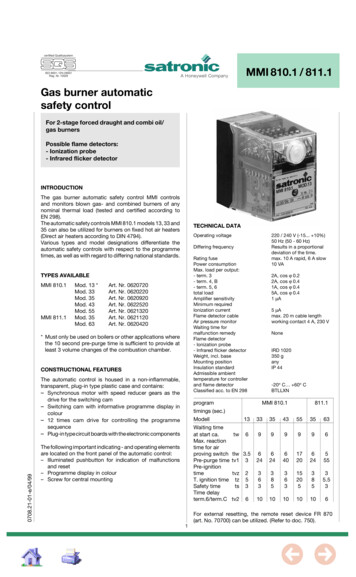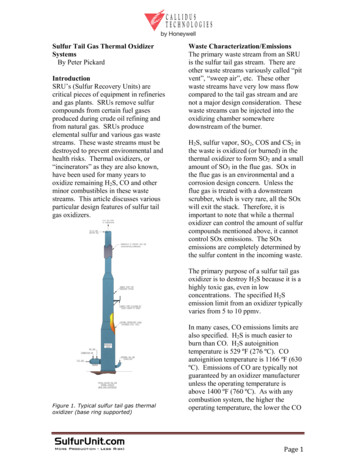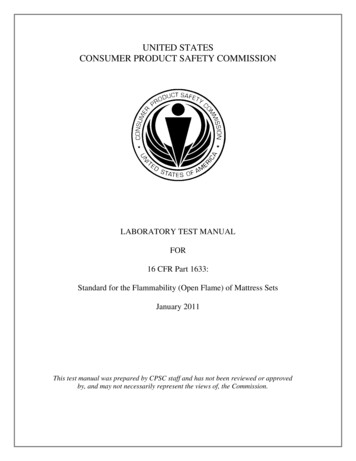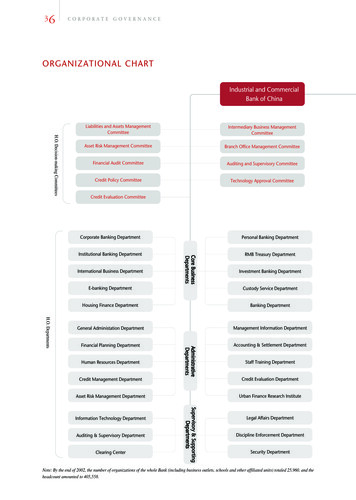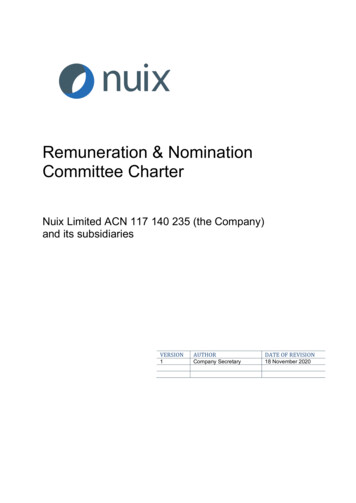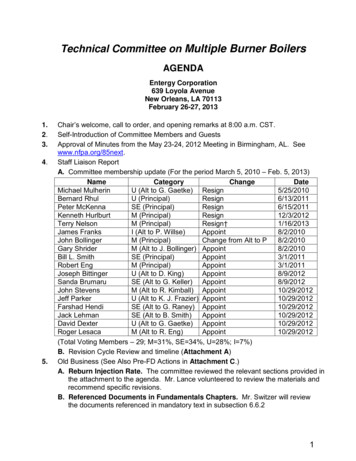
Transcription
Technical Committee on Multiple Burner BoilersAGENDAEntergy Corporation639 Loyola AvenueNew Orleans, LA 70113February 26-27, 20131.2.3.4.5.Chair’s welcome, call to order, and opening remarks at 8:00 a.m. CST.Self-Introduction of Committee Members and GuestsApproval of Minutes from the May 23-24, 2012 Meeting in Birmingham, AL. Seewww.nfpa.org/85next.Staff Liaison ReportA. Committee membership update (For the period March 5, 2010 – Feb. 5, 2013)NameCategoryChangeDateMichael MulherinU (Alt to G. Gaetke) Resign5/25/2010Bernard RhulU (Principal)Resign6/13/2011Peter McKennaSE (Principal)Resign6/15/2011Kenneth HurlburtM (Principal)Resign12/3/2012Terry NelsonM (Principal)Resign†1/16/2013James FranksI (Alt to P. Willse)Appoint8/2/2010John BollingerM (Principal)Change from Alt to P8/2/2010Gary ShriderM (Alt to J. Bollinger) Appoint8/2/2010Bill L. SmithSE (Principal)Appoint3/1/2011Robert EngM (Principal)Appoint3/1/2011Joseph BittingerU (Alt to D. King)Appoint8/9/2012Sanda BrumaruSE (Alt to G. Keller) Appoint8/9/2012John StevensM (Alt to R. Kimball) Appoint10/29/2012Jeff ParkerU (Alt to K. J. Frazier) Appoint10/29/2012Farshad HendiSE (Alt to G. Raney) Appoint10/29/2012Jack LehmanSE (Alt to B. Smith)Appoint10/29/2012David DexterU (Alt to G. Gaetke) Appoint10/29/2012Roger LesacaM (Alt to R. Eng)Appoint10/29/2012(Total Voting Members – 29; M 31%, SE 34%, U 28%; I 7%)B. Revision Cycle Review and timeline (Attachment A)Old Business (See Also Pre-FD Actions in Attachment C.)A. Reburn Injection Rate. The committee reviewed the relevant sections provided inthe attachment to the agenda. Mr. Lance volunteered to review the materials andrecommend specific revisions.B. Referenced Documents in Fundamentals Chapters. Mr. Switzer will reviewthe documents referenced in mandatory text in subsection 6.6.21
C. Consistency with Fundamentals Task Group. NFPA staff requests that allTCs review chapter 4 to determine if specific requirements apply to theircovered equipment, or if any requirements need to be superseded in theequipment-specific chapter. The task group members are D. Lee (chair); R.Eng; J. Frazier; and J. Schexnayder.D. Open-flow Air Path Task Group. The scope of the task group is to review6.5.3.2 for clarity and correctness. NFPA staff will post the original text on thistopic on the NFPA 85 document information page with other committeedocuments. The task group members are D. May (chair); D. Evely; J. Frazier;J. O’Rourke; and H. Wong.E. Design Pressures Task Group. The scope of the task group is to reviewsection 6.5 and its subparagraphs to determine the maximum head developedby booster fans in series with ID fans. The task group members are B. Smith(chair); K. Gamble; D. King; and H. Wong.F. Annexes B and C (Supervised Manual Systems). The committee discussedthe use and continued need for these annexes, which are not activelymaintained by the committee. NFPA Staff will work with Mr. Dressel andmembers of the Technical Committee on Fluid Process Heaters to determine ifNFPA 87 would be a more appropriate location for this information.G. MFT Task Group. The scope of the task group is to address the followingquestions: Should the FD fans remain on upon loss of ID's & MFT for implosionprotection? Should the FD fans remain on upon ID fan runaway? Shouldclosing of natural gas fuel valve be delayed for implosion protection? The taskgroup members are: S. Yates (chair); F. Bennett; D. Dressel; J. Frazier; D.King; S. Kwong; S. Matz; and T. Russell.6. New BusinessA. Create First Revision of Chapter 6. The committee should review the PublicInput (Attachment B) and revise chapter 6 of NFPA 85 as appropriate.B. Review BCS-FUN actions. The committee members are asked to review theactions of the Fundamentals committee (sent under separate cover) and bring forwardany items warranting further discussion.7. Plasma Arc Igniter. The committee briefly discussed the use of plasma arc igniters,indicating awareness of some installations or planned installations outside of the US.Mr. Yates agreed to research further and report to the committee at the First Draftmeeting.8. Other Items?9. Date/Location of Next Meeting. The Second Draft meeting must take place betweenNov. 15, 2013 and January 24, 2014. The BCS-FUN meeting is tentatively scheduledfor Dec 4-5, 2013 in Atlanta, GA. The chair recommends Jan 14-15, 2013.10. Adjournment.2
Attachment A:Fall 2014 Revision Cycle3
2014 FALL REVISION CYCLE*Public Input Dates may vary according to documents and schedules for Revision Cycles may change. Please check the NFPA Website for the most up‐to‐date information onPublic Input Closing Dates and schedules at www.nfpa.org/document # (i.e. www.nfpa.org/101) and click on the Next Edition tabProcessStageProcess StepDates for TCDates for TCwith CCPublic Input Closing Date*Final date for TC First Draft MeetingPosting of First Draft and TC BallotFinal date for Receipt of TC First Draft ballotFinal date for Receipt of TC First Draft ballot ‐ recircPosting of First Draft for CC MeetingFinal date for CC First Draft MeetingPosting of First Draft and CC BallotFinal date for Receipt of CC First Draft ballotFinal date for Receipt of CC First Draft ballot ‐ recircPost Final First Draft for Public 2013Public Comment closing dateFinal Date to Publish Notice of Consent Documents (DocumentsThat Received No Comments)Appeal Closing Date for Consent Documents (15 Days) (DocumentsThat Received No Comments)Final date for TC Second Draft MeetingPosting of Second Draft and TC BallotComment StageFinal date for Receipt of TC Second Draft Ballot(Second Draft)Final date for receipt of TC Second Draft ballot ‐ recircPosting of Second Draft for CC MtgFinal date for CC Second Draft MeetingPosting of Second Draft for CC BallotFinal date for Receipt of CC Second Draft ballotFinal date for Receipt of CC Second Draft ballot ‐ recircPost Final Second Draft for NITMAM 15/20158/27/20157/15/20158/27/2015Public InputStage(First Draft)Notice of Intent to Make a Motion (NITMAM) Closing DateTech SessionPosting of Certified Amending Motions and Consent DocumentsPreparationAppeal Closing Date for Consent Documents (15 Days)(& Issuance)SC Issuance Date for Consent Documents (25 Days)Tech Session Association Meeting for Documents with CAMsAppeals andIssuanceAppeal Closing Date for Documents with CAMs (20 Days)SC Issuance Dates for Documents with CAMs4
Attachment B:Public Input5
National Fire Protection Association tcher?commentParams (.Public Input No. 244-NFPA 85-2013 [ Global Input ]See the uploaded file.Additional Proposed ChangesFile NameDescription85 Proterra 6.5 global.pdfProterra 6.5 global various sectionsApprovedStatement of Problem and Substantiation for Public InputSee uploaded file.Submitter Information VerificationSubmitter Full Name: Joe ProterraOrganization:Proterra-Power LLCSubmittal Date:Mon Jan 07 09:51:35 EST 2013Copyright AssignmentI, Joe Proterra, hereby irrevocably grant and assign to the National Fire Protection Association (NFPA) all and full rights in copyright in thisPublic Input (including both the Proposed Change and the Statement of Problem and Substantiation). I understand and intend that I acquire norights, including rights as a joint author, in any publication of the NFPA in which this Public Input in this or another similar or derivative form isused. I hereby warrant that I am the author of this Public Input and that I have full power and authority to enter into this copyright assignment.By checking this box I affirm that I am Joe Proterra, and I agree to be legally bound by the above Copyright Assignment and the terms andconditions contained therein. I understand and intend that, by checking this box, I am creating an electronic signature that will, upon mysubmission of this form, have the same legal force and effect as a handwritten signature61 of 1712/6/2013 3:15 PM
Report on Proposals – November 2014NFPA 8585- Log #5 BCS-MBBJoe Proterra, Proterra-Power LLC1. It is recommended that NFPA drop the requirements for the structural improvements for implosionprotection to the boiler and duct work on existing boilers.Existing 2011 text: "1.3.1 This code shall apply to new installations and to major alterations or extensions that arecontracted for subsequent to the effective date of this code."This section says boilers with major alterations shall apply, but in the definition Section 3.3.7 it only gives a descriptionfor alteration: "Alteration A change or modification that results in a deviation from the original design specificationsor criteria"It is recommended that this be consistent and called major alteration in the definition section.Also, additional information describing what a major alteration includes, and some examples would be helpful.Also, add in this section that the determination of whether it qualifies as a major alteration or not is up to"An organization, office, or individual responsible for enforcing the requirements ofa code or standard, or for approving equipment, materials, an installation, or a procedure"This is a very important decision by the AHJ on deciding whether the boiler modification actually qualifies as a majoralteration due to the very high cost that is related to complying with NFPA.Throughout Sections 4.6 and 6.5, NFPA refers to “transient design pressure” but does not define what this is. It issuggested that some sort of definition be given to help the reader know what he is dealing with. In 2006 the followingwas provided by Alstom Boiler Co.: It would be helpful to have a definition or an explanation to assist in determining howthis should be handled, maybe get some feedback from the boiler companies on how to best describe this.in85,35”Existing 2011 title of 6.5 isInaddresses positive pressure transient design which is not reflectedin the title 6.5 Furnace Implosion Protection.Maybe change the title of 6.5 to Furnace Positive Pressure and Negative Implosion ProtectionExisting 2011 text: "(A) If the test block capability of the FD fan at ambient temperature is equal to or more positive than 8.7 kPa ( 35 in.of water), the positive transient design pressure shall be at least, but shall not be required to exceed, 8.7 kPa ( 35 in.of water).(B) If the test block capability of the FD fan at ambient temperature is less positive than 8.7kPa ( 35 in. of water), thepositive transient design pressure shall be at least, but shall not be required to exceed, the test block capability of theFD fan."This does not describe what part of the boiler is included in this requirement. Is it just the furnace or does it include theair supply system such as the duct work and equipment between the FD fan and boiler? I would think it includeseverything like it did for the flue gas removal system in the next Recommendation #6.Existing 2011 text:The furnace and flue gas removal system shall be designed so that the maximumhead capability of the ID fan system with ambient air does not exceed the continuous design pressure of the furnace,ducts, and associated equipment."The flue gas removal system is included here but no other sections. Recommend that this be consistent and that theflue gas removal system be included where appropriated when the word furnace is used. Also, a definition should beincluded for flue gas removal system and what equipment this includes which I assume is everything between the boileroutlet to the ID fan inlet: all flue gas ducts, scrubber, bag house, precipitator, etc.Exisiting2011 title of 6.5.2Consider changing this title to of 6.5.2 to "Furnace, Air Supply, & Flue Gas Removal Systems; Positive Pressure andNegative Implosion Protection"Also, this control section is all written around monitoring the boiler furnace which protects the furnace, but does notPrinted on 1/7/201317
Report on Proposals – November 2014NFPA 85necessarily protect the air ducts, and flue gas removal system. Some examples are as follows: The pressure in the furnace could be 0”wg while the air ducts could be at 50”wg. The boiler back-end equipment such as the air heater, scrubber, or bag house could be plugged which could allowthe suction pressure following this equipment to be -50”wg while the pressure in the furnace is operating at 0”wg.On a past job I worked on, this was recognized and a pressure transmitter was added at the inlet to the ID fan whichwas capable of developing -45”wg. The controls were set to trip the ID fan at -35”wg which the preceding duct-work andequipment were designed for.Recommend that wording be added to cover the protection of the air system and flue gas removal system.The changes that I will be addressing are in Section 6.5.When boilers have modifications that could fall under the definition of “major alterations” in Section 1.3.1, this requiresthat these existing boilers follow the latest NFPA requirements including Section 6.5.I understand the requirements in Sections 6.5.1.3.2.1 and 6.5.1.3.2.2 that NFPA put on new units for the furnacedesign pressure shall be equal to the capability of the FD & ID fans or to35”wg, which can be done at a reasonablecost. Did NFPA realize the ramification of placing these same requirements on existing units that qualify for “majoralteration”? It is typical to have older furnaces designed for7”wg with fans that far exceed these pressures. Toincrease the furnace design to 35”wg can be very expensive, and if the air and flue gas ducts are included in thestructural upgrades, the engineering cost can be 100,000 to 200,000 and material and labor be 1 to 2 million perboiler. The structural upgrades to existing units can get expensive because the insulation and lagging has to beremoved and stiffeners added to duct work and buckstays added to the boiler.These older boilers have been protected for many years with their normal high and low furnace pressure monitoringand tripping systems, and by placing the increase structural design parameters on these boilers is believed to be anextreme. I feel that existing boilers with a “major alteration” should be required to follow Section 6.5.2to protect the furnace, but not be required to do the structural upgrades in Sections 4.6 and 6.5.NFPA states (in similar words) that the furnace etc. design pressure should be designed to meet the pressurecapability of the FD & ID fans or to 35”, and if the fans exceed /- 35"wg then the furnace shall be protectedaccording to 6.5.2. I wonder why NFPA allows the equipment to be protected with theuse of a furnace pressure control system in this case when the fans exceed35”wg, but does not allow this samecontrol system to protect existing boilers at a lower pressure without implementing the structural upgrades.In all my 40 years of working on boilers, I have never heard of a boiler that experienced damage from the FD and IDfans by either blowing out or sucking in the equipment to the point where damage occurred. I have also asked the boilercompanies for any known examples of this occurring, and they could not come up with any. I am sure this must haveoccurred in the past, but the point I am trying to make, is this is not a common occurrence and NFPA should not requirethe structural upgrades to existing boilers when they can be protected by other means.I don’t believe there is any mention by NFPA about protecting the boiler and duct work with relief-dampers (vacuumbreakers) which have been used and still are in use on some boilers. I don’t really like using these because they usuallyget neglected and may not function when needed. I would like the option to use these though versus spending 2 millionon structural upgrades, and would have no issue doing it as long as the boiler was protected with the recommendedNFPAin Section 6.5.2.When using NFPA 85 as it relates to boilers with “major alterations” that could require structural upgrades to increasethe furnace design pressure according to Sections 4.6 and 6.5, I thought the changes would be helpful to otherengineers performing similar evaluations.Printed on 1/7/201328
National Fire Protection Association tcher?commentParams (.Public Input No. 42-NFPA 85-2012 [ Section No. 6.2.4 ]6.2.4This chapter shall not eliminate the need for competent engineering judgment.Statement of Problem and Substantiation for Public InputThe principal requirement of clause 6.2.4 is define under clause 1.3.2 and thus, clause 6.2.4 is redundant. Clause1.3.2.1 and 1.3.2.2 state the designer has the latitude and responsibility for demonstrating and documenting thevalidity of the proposed design. These requirements provide a more enforceable language than the requirements ofa “competent judgment”Submitter Information VerificationSubmitter Full Name: Daniel LeeOrganization:ABB IncorporatedSubmittal Date:Mon Nov 12 08:10:34 EST 2012Copyright AssignmentI, Daniel Lee, hereby irrevocably grant and assign to the National Fire Protection Association (NFPA) all and full rights in copyright in this PublicInput (including both the Proposed Change and the Statement of Problem and Substantiation). I understand and intend that I acquire no rights,including rights as a joint author, in any publication of the NFPA in which this Public Input in this or another similar or derivative form is used. Ihereby warrant that I am the author of this Public Input and that I have full power and authority to enter into this copyright assignment.By checking this box I affirm that I am Daniel Lee, and I agree to be legally bound by the above Copyright Assignment and the terms andconditions contained therein. I understand and intend that, by checking this box, I am creating an electronic signature that will, upon mysubmission of this form, have the same legal force and effect as a handwritten signature914 of 1712/6/2013 3:15 PM
National Fire Protection Association tcher?commentParams (.Public Input No. 189-NFPA 85-2013 [ New Section after 6.3.3.1 ]6.3.3.2 Two safety shutoff valves in series shall be provided in the fuel gas line to the individualburners, and an automatic vent valve shall be provided between each set of two safety shutoffvalves. When a listed automatic valve-proving system is used with two safety shutoff valves inseries, each with a proof of closure switch, the automatic vent valve shall be permitted to beomitted.Statement of Problem and Substantiation for Public InputSee related Public Input 188. Add as new 6.3.3.2 and re-number thereafter. This change is suggested to moreclearly identify the current requirement for two safety shutoff valves at each individual burner as shown in FigureA.6.6.5.1.5.4(b) and allow the option of using a valve proving system in place of a vent valve, as presently allowedin 5.3.2.3.Submitter Information VerificationSubmitter Full Name: Ted JablkowskiOrganization:Fives North American CombustioSubmittal Date:Thu Jan 03 11:18:45 EST 2013Copyright AssignmentI, Ted Jablkowski, hereby irrevocably grant and assign to the National Fire Protection Association (NFPA) all and full rights in copyright in thisPublic Input (including both the Proposed Change and the Statement of Problem and Substantiation). I understand and intend that I acquire norights, including rights as a joint author, in any publication of the NFPA in which this Public Input in this or another similar or derivative form isused. I hereby warrant that I am the author of this Public Input and that I have full power and authority to enter into this copyright assignment.By checking this box I affirm that I am Ted Jablkowski, and I agree to be legally bound by the above Copyright Assignment and the terms andconditions contained therein. I understand and intend that, by checking this box, I am creating an electronic signature that will, upon mysubmission of this form, have the same legal force and effect as a handwritten signature1015 of 1712/6/2013 3:15 PM
National Fire Protection Association tcher?commentParams (.Public Input No. 188-NFPA 85-2013 [ Section No. 6.3.3.1 ]6.3.3.1A header safety shutoff valve and individual burner safety shutoff valves shall be provided.Statement of Problem and Substantiation for Public InputSee related Public Input 188. The objective of this Public Input is to revise 6.3.3.1 to more clearly identify thecurrent requirement for a common Header safety shutoff valve and the requirement for two saftey shutoff valves foreach individual burner with a vent valve between them, as shown in Figure A.6.6.5.1.5.4(b) and to provide the optionof using a valve proving system in place of the vent valve as is permitted in 5.3.2.3. Related Public Input 188 wassubmitted to complete this suggested change.Related Public Inputs for This DocumentRelated InputRelationshipPublic Input No. 189-NFPA 85-2013 [New Section after 6.3.3.1]Submitter Information VerificationSubmitter Full Name: Ted JablkowskiOrganization:Fives North American CombustioSubmittal Date:Thu Jan 03 11:11:42 EST 2013Copyright AssignmentI, Ted Jablkowski, hereby irrevocably grant and assign to the National Fire Protection Association (NFPA) all and full rights in copyright in thisPublic Input (including both the Proposed Change and the Statement of Problem and Substantiation). I understand and intend that I acquire norights, including rights as a joint author, in any publication of the NFPA in which this Public Input in this or another similar or derivative form isused. I hereby warrant that I am the author of this Public Input and that I have full power and authority to enter into this copyright assignment.By checking this box I affirm that I am Ted Jablkowski, and I agree to be legally bound by the above Copyright Assignment and the terms andconditions contained therein. I understand and intend that, by checking this box, I am creating an electronic signature that will, upon mysubmission of this form, have the same legal force and effect as a handwritten signature1116 of 1712/6/2013 3:15 PM
National Fire Protection Association tcher?commentParams (.Public Input No. 73-NFPA 85-2012 [ Section No. 6.3.3.7 ]6.3.3.7Burner and igniter safety shutoff valves shall be located as close as practicable to the igniters orburners to minimize the volume of fuel downstream of the valve.Statement of Problem and Substantiation for Public InputThe content in 6.3.3.7 is covered in 4.7.7.13Submitter Information VerificationSubmitter Full Name: Kenneth FrazierOrganization:Salt River ProjectSubmittal Date:Thu Dec 06 12:14:47 EST 2012Copyright AssignmentI, Kenneth Frazier, hereby irrevocably grant and assign to the National Fire Protection Association (NFPA) all and full rights in copyright in thisPublic Input (including both the Proposed Change and the Statement of Problem and Substantiation). I understand and intend that I acquire norights, including rights as a joint author, in any publication of the NFPA in which this Public Input in this or another similar or derivative form isused. I hereby warrant that I am the author of this Public Input and that I have full power and authority to enter into this copyright assignment.By checking this box I affirm that I am Kenneth Frazier, and I agree to be legally bound by the above Copyright Assignment and the terms andconditions contained therein. I understand and intend that, by checking this box, I am creating an electronic signature that will, upon mysubmission of this form, have the same legal force and effect as a handwritten signature1217 of 1712/6/2013 3:15 PM
National Fire Protection Association tcher?commentParams (.Public Input No. 72-NFPA 85-2012 [ Section No. 6.4.1 ]6.4.1 * Unattended and Off-Site Operation.Unattended operation, no operator at the operating location(s), or operation of the plant from anoff-site operating location shall require a higher level of automation, safety interlocks, and reliability,which are not addressed in this code.6.4.1.1In addition to operational and safety analysis, designs for off-site and unattended operations shallinclude risk analysis and hazard studies and shall be approved by the authority having jurisdiction.6.4.1.2Jurisdictional requirements regarding operator attendance shall be met.Statement of Problem and Substantiation for Public InputThe content in 6.4.1, 6.4.1.1, 6.4.1.2 & A.6.4.1 is covered in 4.1.4. it is proposed that the content of A.6.4.1 beadded as a new comment to A.4.1.4.Submitter Information VerificationSubmitter Full Name: Kenneth FrazierOrganization:Salt River ProjectSubmittal Date:Thu Dec 06 12:05:47 EST 2012Copyright AssignmentI, Kenneth Frazier, hereby irrevocably grant and assign to the National Fire Protection Association (NFPA) all and full rights in copyright in thisPublic Input (including both the Proposed Change and the Statement of Problem and Substantiation). I understand and intend that I acquire norights, including rights as a joint author, in any publication of the NFPA in which this Public Input in this or another similar or derivative form isused. I hereby warrant that I am the author of this Public Input and that I have full power and authority to enter into this copyright assignment.By checking this box I affirm that I am Kenneth Frazier, and I agree to be legally bound by the above Copyright Assignment and the terms andconditions contained therein. I understand and intend that, by checking this box, I am creating an electronic signature that will, upon mysubmission of this form, have the same legal force and effect as a handwritten signature1318 of 1712/6/2013 3:15 PM
National Fire Protection Association tcher?commentParams (.Public Input No. 47-NFPA 85-2012 [ Section No. 6.4.2.1 ]6.4.2.1 General.6.4.2.1.1The basic requirements of an interlock system for a unit shall accomplish the following:(1) Protect personnel from injury(2) Protect equipment from damage(3) Protect boiler operation by limiting actions to a prescribed operating sequence or by initiatingtrip devices when approaching an out-of-range or unstable operating condition6.4.2.1.2The interlock system shall comply with Section 4.11 .6.4.2.1.3 *The mandatory automatic trips specified in 6.4.2.3 shall be provided.6.4.2.1.4Additional automatic trips shall be permitted. (See 4.1.3 for trip function evaluation requirements.)6.4.2.1.5Fuel-specific interlocks shall be provided for each design basis fuel.6.4.2.1.6 *Operating personnel shall be made aware of the limitations of the interlock system.Statement of Problem and Substantiation for Public InputThis public input is submitted in combination with public inputs to move clause 6.4.2.1 to the Fundamental chapter.6.4.2.1 delete clause title6.4.2.1.1 requirement is to be moved to the Fundamental 4.11.1 (new) – see corresponding public input6.4.2.1.2 requirement is to be move under 4.11 and thus this clause can be deleted6.4.2.1.3 requirement only reference another clause and provides no code/design requirements. The appendixreference is to be moved to 6.4.2.3 – see corresponding public input6.4.2.1.4 requirement is to be moved to the Fundamental 4.11.1 (new) – see corresponding public input6.4.2.1.5 requirement is to be moved to the Fundamental 4.11.1 (new) – see corresponding public input6.4.2.1.6 requirement is to be moved to the Fundamental 4.11.1 (new) – see corresponding public inputSubmitter Information VerificationSubmitter Full Name: Daniel LeeOrganization:ABB IncorporatedSubmittal Date:Mon Nov 19 10:46:35 EST 2012Copyright AssignmentI, Daniel Lee, hereby irrevocably grant and assign to the National Fire Protection Association (NFPA) all and full rights in copyright in this PublicInput (including both the Proposed Change and the Statement of Problem and Substantiation). I understand and intend that I acquire no rights,including rights as a joint author, in any publication of the NFPA in which this Public Input in this or another similar or derivative form is used. Ihereby warrant that I am the author of this Public Input and that I have full power and authority to enter into this copyright assignment.By checking this box I affirm that I am Daniel Lee, and I agree to be legally bound by the above Copyright Assignment and the terms andconditions contained therein. I understand and intend that, by checking this box, I am creating an electronic signature that will, upon mysubmission of this form, have the same legal force and effect as a handwritten signature1419 of 1712/6/2013 3:15 PM
National Fire Protection Association tcher?commentParams (.Public Input No. 208-NFPA 85-2013 [ Section No. 6.4.2.2.14 ]6.4.2.2.14The mandatory master fuel trip–sensing elements and circuits shall be independent of all other controlelements and circuits.Exception No. 1: Individual burner flame detectors also shall be permitted to be used for initiatingmaster fuel trip systems.Exception No. 2: Airflow measurement, auctioneered furnace draft, and drum water level signalsfrom the boiler control system shall be permitted to be used for a master fuel trip, provided all thefollowing conditions are met:(1) These interlocks are hardwired into the burner management system.(2) Tripping set points are protected from unauthorized changes.(3) Any single component failure of these sensing elements and ci
New Business . A. Create First Revision of Chapter 6. The committee should review the Public Input (Attachment B) and revise chapter 6 of NFPA 85 as appropriate. B. Review BCS-FUN actions. The committee members are asked to review the actions of the Fundamentals committee (sent under separate cover) and bring forward
